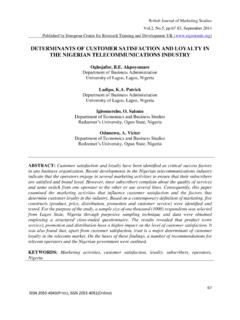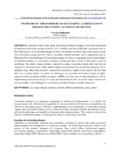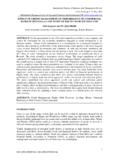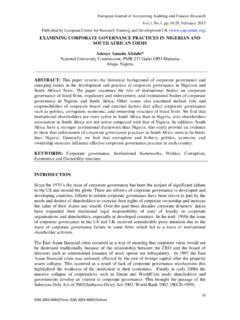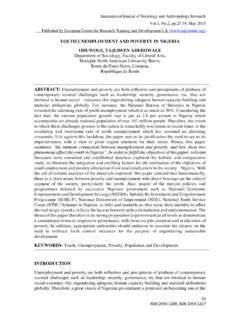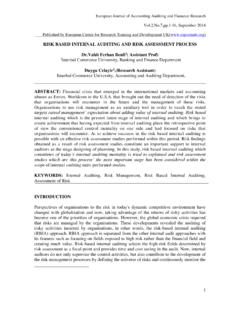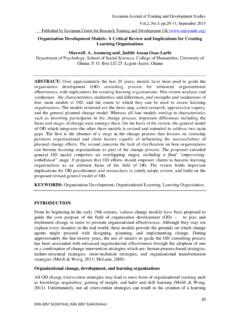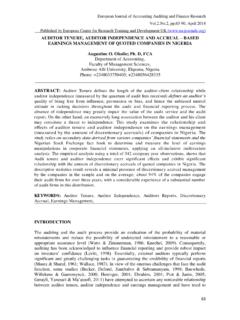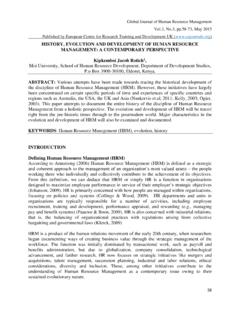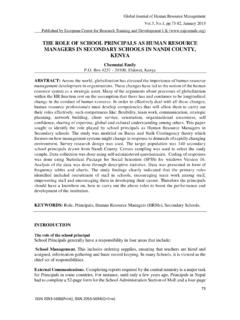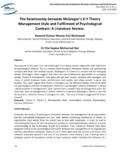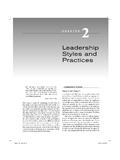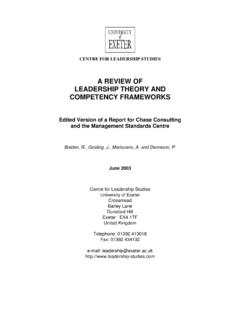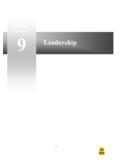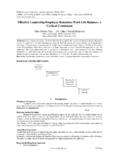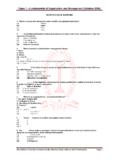Transcription of FACTORS INFLUENCING MOTIVATIONLEVELOF …
1 Global Journal of Human Resource Management , March 2013, Published by European Centre for Research Training and Developmental ( ) 41 FACTORS INFLUENCING MOTIVATIONLEVELOF ACADEMIC STAFF IN EDUCATIONSECTOR OF PAKISTAN Mubbsher Khan1* and Hira Tahir Mansoor2 1&2 Hailey College of Commerce, University of the Punjab, Lahore, Pakistan. Abstract: The aim of the research was to determine the relationship between rewards and work motivation of Public Sector College teachers of Pakistan. A Questionnaire was used to collect information from 200 respondents.
2 It was composed of 37 items that measured rewards and overall motivation of academic staff. Rewards were measured using five dimensions namely: pay, working conditions, job security, work itself and recognition. Data analysis was done using correlations and regression techniques. Work itself and recognition had statistically strong positive and significant association with motivation of teachers. However weaker relationship was found with working conditions and pay. This study conducted upon college/university teachers can also be conducted upon school teachers and other sector organizations.
3 Dimensions of rewards, other than the five, used in this study can also be taken to determine their association with motivation as well as impact of demographics on motivation. Keywords: Motivation, pay, recognition, work itself, working condition, job security Introduction Human Resource Management refers to the management of intellectual resources and focuses on fulfilling requirements of management. Needs and wants of workers can be met through well organized management (Torrington & Hall, 1998). Today, the most valuable aspect for the economic stability of a country is the knowledge and competence of employees.
4 These human skills come from job satisfaction and motivation that enable employees to carry out their routine tasks effectively (Litschka, Markom, & Schunder, 2006). To enable workers to get motivated, managers must understand the trends that mould their behavior (Hanson & Miller Jr, 2002). The term motivation originated from the Latin word movere which mean to make some movement (Kreitner & Kinicki, 2004). Over the years, many analysts have defined it in a variety of ways. They are of the view that it is the behavior intended towards a specific aim.
5 We can define motivation as internal and external FACTORS that inspire the eagerness and enthusiasm in individuals to be devoted towards a task and to make constant exertion to accompolish that task. (Shafiq, Mariam, & Raza, 2011). Aim of this study is to determine the relationship between rewards and motivation level of academic staff of four public sector colleges, located in Lahore, Pakistan. Literature Review Motivation of employees is thought to be the most important objective of human resource practitioners as approximately all of them have basic intention to instill in them a feeling of commitment, devotion and satisfaction towards their work (Jerris, 1999).
6 Lawler (1973) was of the view that motivation is the best predictor of employee performance. Robbins (2001) defined motivation as the a person s interest to make high level of exertion to accomplish organizational goals, conditioned by effort s capability to fulfill an individual s need . Motivation is basically an internal force (Pepitone & Bruce, 1998). It is a tool that leads human behavior towards satisfaction of his desires and wants (Schuler, 1998). Nohria, Groysberg, and Lee (2008) found that motivation can be determined by variety of FACTORS that include retention, commitment and satisfaction.
7 Many theories have been developed concerning motivation of employees. A lot of work has been done in the literature concerning motivational FACTORS . In order to maximize the performance of employees, organizations must formulate such policies, procedures and reward system which would improve employees satisfaction and motivation. Performance of an organization depends upon the performance of its employees. Employees rewards and incentives can be the tools for improving their performance. Global Journal of Human Resource Management , March 2013, Published by European Centre for Research Training and Developmental ( ) 42 Several theories have been developed by various analysts relating to employees motivation towards work.
8 These theories are still widely implemented in various organizations. These involve content as well as process theories. Content theories are based upon such elements that exist inside human beings that tend to motivate them and describe the reason behind changing needs of a person with the passage of time, whereas process theories provide description of behavior that is evolved by a person. These are explained below. Maslow s Hierarchy of Needs: Abraham Maslow (1954) developed a theory called Hierarchy of Needs. He identified five levels of needs in the hierarchy and displayed these in the form of a pyramid with the most fundamental needs at the bottom and the need for self-actualization at the top of pyramid.
9 It includes the physiological needs (food, shelter for living and certain material wants); safety and security needs (protection from physical and mental destruction); social needs (sense of affection, concern, belongingness and friendship with others); self-esteem (acknowledgement and admiration); and self-actualization need (to have those rights which a person deserves). Theory X and theory Y: This theory was developed by (McGregor, 1960).According to theory X, organization considers that its employees are very idle and lethargic. Moreover managers consider that their employees do not like to work, they usually avoid performing their duties, and they have no aim to flourish in life.
10 According to theory Y, supervisors believe that employees are energetic, active; self-determined and implement willpower. They assume that employees enjoy their job, they take it as a challenge, and they don t take it as a burden, try their best to complete their tasks within the limited time and are goal oriented. Herzberg s Two Factor Theory: Herzberg (1959) proposed a theory in which he differentiated between FACTORS of satisfaction and FACTORS of dissatisfaction at work, known as Two Factor theory. Herzberg broadened the theory that was proposed by Abraham Maslow.
